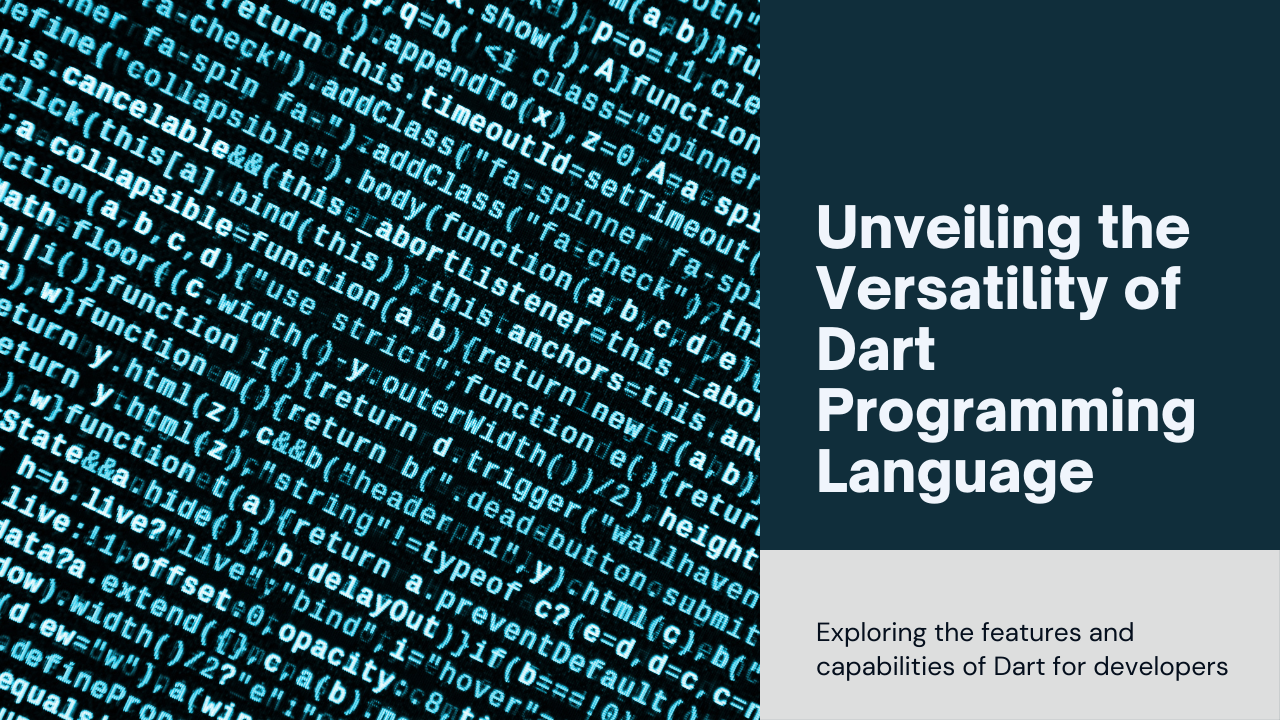Flutter, Google’s open-source UI toolkit, has revolutionized cross-platform app development by allowing developers to create natively compiled applications for mobile, web, and desktop from a single codebase. At the heart of Flutter’s architecture is Dart, a powerful programming language designed to enhance the development experience and performance. Understanding Dart’s role in Flutter development is crucial for leveraging the full potential of this modern toolkit. In this blog, we’ll explore Dart’s significance, its features, and how it integrates with Flutter to create high-quality applications.
Understanding Dart: An Overview
What is Dart?
Dart is an object-oriented, class-based programming language developed by Google. It is designed to be easy to learn, efficient to use, and highly productive. Dart’s syntax is similar to other C-style languages, making it accessible for developers familiar with languages like JavaScript, Java, or C#. Dart is optimized for building user interfaces, making it a natural fit for Flutter.
Why Dart for Flutter?
Dart was chosen for Flutter because of its unique features that align well with Flutter’s goals:
- Performance: Dart compiles to native code, which helps in delivering high-performance applications.
- Productivity: Features like hot reload and a rich set of libraries streamline the development process.
- Consistency: Dart provides a consistent development experience across different platforms, aligning with Flutter’s cross-platform capabilities.
Dart’s Key Features and Benefits
AOT and JIT Compilation
Dart offers two types of compilation: Ahead-of-Time (AOT) and Just-In-Time (JIT). Each plays a crucial role in Flutter development:
- AOT Compilation: AOT compilation converts Dart code into native machine code before runtime, resulting in fast execution and reduced startup time. This is particularly important for delivering smooth and responsive user experiences in production apps.
- JIT Compilation: JIT compilation allows Dart code to be compiled at runtime, enabling features like hot reload during development. This significantly speeds up the development cycle by allowing developers to see changes instantly without restarting the app.
Rich Standard Library
Dart comes with a comprehensive standard library that provides a wide range of built-in functionalities. This includes collections, asynchronous programming support, and utilities for handling JSON, among others. These features help developers build robust and efficient applications without needing to rely on external libraries for common tasks.
Null Safety
Dart’s null safety feature helps developers avoid common programming errors related to null values. By ensuring that variables cannot be null unless explicitly declared, Dart reduces the likelihood of null reference exceptions and enhances code reliability. This is particularly useful in Flutter development, where maintaining a stable and error-free codebase is critical for delivering high-quality apps.
Dart’s Integration with Flutter
Widgets and the Widget Tree
In Flutter, everything is a widget. Dart’s role in Flutter is to manage and build these widgets. The widget tree represents the hierarchy of widgets in a Flutter application. Dart’s object-oriented principles and class-based structure enable developers to create and manage complex widget hierarchies efficiently.
- State Management: Dart facilitates state management in Flutter by providing the necessary tools and structures. Using Dart’s classes and objects, developers can create stateful widgets and manage their state effectively.
- Custom Widgets: Dart allows developers to build custom widgets by extending existing ones and creating reusable components. This modular approach enhances code organization and maintainability.
Asynchronous Programming
Dart’s support for asynchronous programming is a crucial aspect of Flutter development. Asynchronous operations, such as network requests or file I/O, are essential for creating responsive applications. Dart provides Future and Stream classes to handle asynchronous operations effectively, ensuring that Flutter apps remain smooth and responsive.
- Future: Used for single asynchronous results. It represents a value that will be available in the future.
- Stream: Used for handling a sequence of asynchronous events. It allows developers to work with continuous data flows, such as user input or real-time updates.
Hot Reload and Development Workflow
Hot reload is one of Flutter’s standout features, significantly enhancing the development experience. Dart’s support for JIT compilation enables this feature, allowing developers to see changes instantly without restarting the app. This speeds up the development process, making it easier to experiment, debug, and refine applications.
Dart’s Role in Enhancing Performance
Optimized Rendering
Dart’s efficiency in compiling to native code contributes to Flutter’s high-performance rendering. By converting Dart code directly to native machine code, Flutter apps can achieve smooth animations and quick response times. This is particularly important for applications requiring high frame rates and seamless user interactions.
Efficient Memory Management
Dart’s garbage collection mechanism helps manage memory efficiently, reducing the risk of memory leaks and improving application stability. Dart’s memory management features are designed to handle the dynamic nature of Flutter applications, ensuring that resources are allocated and released appropriately.
Best Practices for Dart in Flutter Development
Code Organization and Modularity
Organizing code into modular components is essential for maintaining a clean and manageable codebase. Dart’s class-based structure supports this approach, allowing developers to create well-defined classes and packages. This modularity enhances code readability and simplifies maintenance.
Effective Use of Asynchronous Features
Utilizing Dart’s asynchronous programming features effectively ensures that Flutter apps remain responsive and efficient. Properly handling Future and Stream operations helps manage data flow and avoid blocking the main thread, contributing to a smooth user experience.
Adopting Null Safety
Taking advantage of Dart’s null safety feature improves code reliability and reduces the likelihood of runtime errors. Ensuring that variables are correctly initialized and handling potential null values explicitly enhances the overall stability of Flutter applications.
The Future of Dart in Flutter Development
Ongoing Improvements
Dart continues to evolve, with ongoing improvements and new features being introduced regularly. Future updates to Dart are expected to enhance its capabilities and address emerging challenges in mobile and web development. Staying informed about Dart’s developments ensures that developers can leverage new features and optimizations in their Flutter projects.
Integration with Other Technologies
As Flutter expands its reach beyond mobile applications, Dart’s integration with other technologies and platforms will play a key role. Future developments may include enhanced support for web and desktop applications, further extending Dart’s utility in the broader technology ecosystem.
Conclusion
Dart plays a fundamental role in Flutter development, providing a powerful and efficient programming environment for building cross-platform applications. Its features, including AOT and JIT compilation, rich standard library, and null safety, contribute significantly to the performance, productivity, and reliability of Flutter apps. By understanding Dart’s capabilities and integrating best practices into your development workflow, you can harness the full potential of Flutter and create high-quality, high-performance applications.
As Flutter and Dart continue to evolve, staying updated with the latest advancements and features will ensure that your development practices remain cutting-edge. With Dart as the backbone of Flutter, the future of cross-platform app development looks promising and full of potential.







